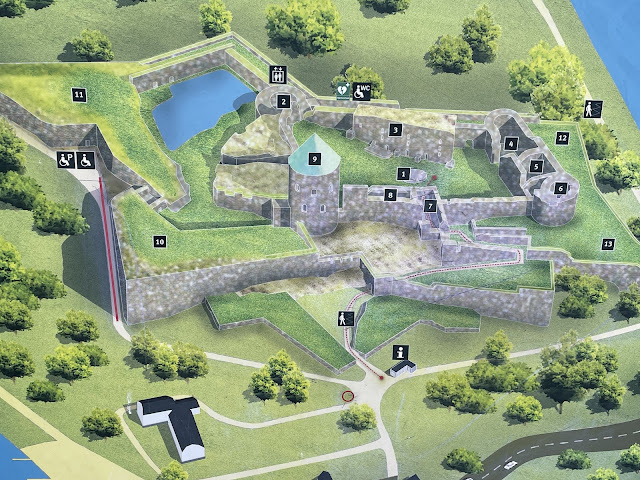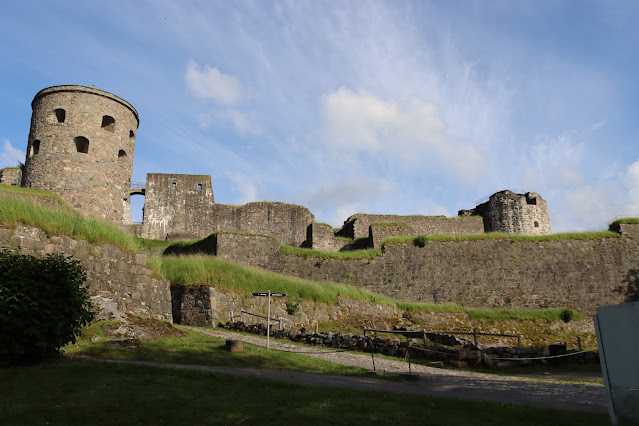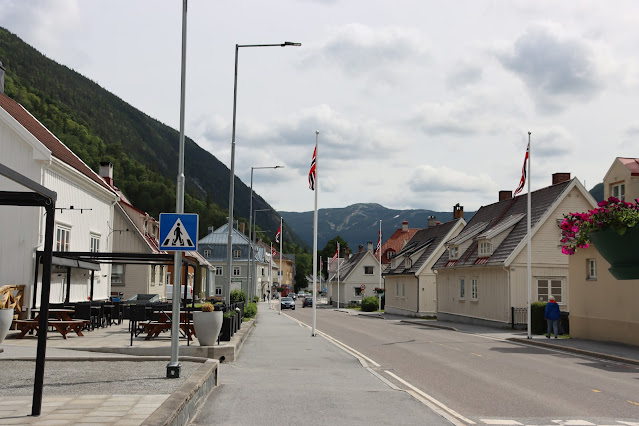Swedish National day gave us a 'squeeze' weekend - a public holiday on a Thursday, allowing for a four day weekend with only a single day of leave.
We had a few thoughts about where we would go to take advantage of the time, but there was one option that really stood out. Our friend, Thomas, in Norway had offered to host us when we were available, and the four days allowed us enough time to get up there and back and still have time to spend with him and explore the area.
Despite the short notice, Thomas was free and organised a cabin in a town called Veggli in Norway:
Veggli is a small town in the county of Buskerud and the municipality of Rollag, lying on the Numedalslågen River. The Vegglifjell mountain range sits along the border of Buskerud and Telemark counties and has a high point of 1,380m, on the Skirveggan Mountain.
The cabin that we were going to be staying at was in Vegglifjell.
We left Malmö on Wednesday night after work and school and headed up to Strömstad, most of the way to Oslo. We had intended to stay in Oslo for the first night, so we could revisit the city, but the accomodation was too expensive. Strömstad was familiar to us as it was where we usually caught the ferry to Sandefjord when had visited Thomas previously.
On the way there we stopped at Bohus Fastning - a medieval castle that previously stood on the Norwegian/Swedish border. It was built in 1308 by king Haakon V Magnuson of Norway, who had also commanded the construction of Akershus Castle in Oslo. The castle was attacked 14 times but never captured. The Swedes did gain access to the northeastern tower in 1566, but the Norwegian soldiers detonated the tower's gunpowder magazine which blunted the attack. The castle was given to Sweden as part of the Treaty of Roskilde in 1658. The Norwegians attacked in 1678 and did serious damage to the fortress, before being routed by a Swedish army. Since the castle was no longer on the border it was repaired and turned into a prison and slated to be demolished in the late 1700s. Demolition crews worked for two months before running out of finances.
The main remaining tower is known as Father's Hat (Fars hatt).
We arrived in Strömstad 9pm and our accommodation was a small holiday cabin in a wooded area. The kids had an upstairs floor, accessible by a ladder and Kris and I had the sofa bed downstairs.
 |
| The hinges holding the ladder on were a bit of a worry... |
 |
| Crossing the border to Norway |
After a good night sleep, we headed into Oslo. Parking was hard to find and in the end we settled for a parking garage - a decision that would cost us 380 NOK or $54 for 3 hours. Our first stop in Oslo was Akershus Fortress, a medieval castle built in the 1290s to protect Oslo and to serve as a royal residence.
The fortress was subjected to several sieges (usually by the Swedes). In 1308 the Swedish Duke Eric of Södermanland attacked but was driven away by a Norwegian army. In 1449 the Swedish King Karl Knutsson Bonde laid a siege which was unsuccessful. The Danes tried next, in 1502 using Scottish Soldiers. Not to be outdone, the Swedes attacked in 1523, but the citizens of Oslo burned down their own houses, forcing the Swedes to retreat. Another siege by King Christian II occurred 1531-1532 and the Swedes attacked again in 1567. In this case the city was burned down by the defenders, forcing the Swedes to retreat.
In World War II, the fortress surrendered without combat to Nazi Germany in 1940, with the Norwegian government evacuating. The fortress was liberated on 11 May 1945.
 |
| Damage on the Cannon |
 |
| Looking across the harbour at Oslo |
After leaving the fortress, we walked down to Oslo City Hall, one of the buildings we remembered most from our previous visit. Unfortunately it was undergoing significant renovations and also closed for a 'Studenten' graduation ceremony, so we could only get a few photos of its impressive murals. The Viking Boat Museum was also closed, so we walked to the Nobel Peace Museum and Kristine bought some books for school resources.
 |
| Closed off an under construction |
 |
| Looking away from the City Hall, including some students in traditional dress |
 |
| All we could see of the murals |
 |
| Nobel Peace Museum |
By now the kids were hungry, so we headed towards central station where we got some food and then headed back to the car.
 |
| "She Lies", representing an Iceberg, changes direction with currents and wind |
 |
| Stortinget - Parliament Building |
 |
| Tiger Sculpture near Oslo. |
Oslo is known as Tigerstaden (The Tiger City) from a poem "Sidste Sang" by poet Bjørnstjerne Bjørnson in 1870. The poem details a fight between a horse and a tiger, with the horse being the safe countryside and the tiger being the dangerous city. This statue was gifted to Oslo in 2000 on it's 1000th anniversary by property company Eiendomsspar.
 |
| "Knus Nazismen (Crush Nazism)" showing a hammer smashing the Swastika to commemorate the Norwegian resistance group Osvald Group |
Our final stop in Oslo was one of my favourite places - Frogner Park and the Vigeland Sculpture park. I addressed the park in a fair amount of detail in my previous visits: 29 Feb 2016 and 15 Feb 2018, so I won't go into detail here, only share a few quick photos.
 |
| Take that, wolf! |
 |
| Ever hugged anyone so hard their skeleton popped out and went for a walk? |
 |
| Mum, look what i killed! |
 |
| Those poor wolves. Was this before or after it got kicked? |
 |
| Man attacked by babies |
 |
| Angry Baby! |
After finishing up at the park around 3pm, we drove into Veggli to see the Veggli Troll and meet up with our favourite Norwegian.
 |
| The Veggli Troll |
 |
| Road to the cabin |
 |
| The cabin |
Kristine did quite a bit of birdwatching from the cabin:
 |
| Great Spotted Woodpecker, or "Flaggspett" (Flag Pecker) |
 |
| A fox (not a species of bird) |
Thomas led us up into the mountains where we came to the amazing cabin that would be our home for the next three nights. We unpacked, cooked dinner and caught up with Thomas - we'd last seen him when he came down to Malmö for a visit in September.
The next day was tourist day and Thomas, our local tour-guide, led us to the top of the mountain at Killingskaret where the views were amazing, elevation was about 1130m above sea level.
 |
| Snow |
After taking in the views and the fact there was still snow in June, we headed down to Rjukan. Located in Tinn Municipality, Rjukan lies in the Vestfjorddalen valley. The town was built in order to house workers for Norsk Hydro. It lies along the valley on the river Måna. Due to its location in the valley, the town does not receive any direct sunlight from September to March - it is blocked by the Gausta mountain to the south. To deal with this, an 'art' project costing 5 million Norwegian Kronor (~AUD$700,000) placed large mirrors on the northern mountains to reflect sun into the town center. The Sunmirror in Rjukan was built in 2013.
 |
| Sheep on the road to Rjukan |

 |
| Lake Tinnsjø |
 |
| Electric Arc Furnace |
In the center of Rjukan are some artifacts from the Hydro plants. The Electric Arc Furnace was built in 1912 to extract Nitrogen from air as part of the Bikeland/Eyde process (see the section on Vemork for more details). This is one of fourty furnaces installed at the Rjukan II plant and was in use until 1941.
The turbine below is a Pelton Turbines showing the runner and nozzle for an impulse water turbine for driving an electric power generator.
 |
| Såheim Hydroelectric Power Station |
 |
| The sun mirror |
 |
| Looking up at the sun mirror |
 |
| Main Square |
 |
| Gausta Mountain |
After checking out the sunmirror and town square, we headed to our next stop - the Krossobanen Cable Car. Built in 1928, it was the first cable car built in Northern Europe, built to allow the Rjukan citizens to access the top of the mountain and see the sun. It was a gifted to the town by Nork Hydro.
There are two cable cars, "Tyttebær" (cranberry) and "Blåbær" (blueberry) that travel 886m to the base of the Hardangervidda Plateau.
We enjoyed the views from the top, looking over the pyramid-shaped Gausta mountain, which had been site of a NATO military radio relay station from 1954-1959 and still houses an internal funicular railway. We also got our first glimpse of our next stop, the Vemork Hydro Plant.
 |
| Statue of Knut Magne Haugland - one of the Vemork saboteurs |
 |
| Rjukan with Mount Gausta |
 |
| Såheim Hydroelectric Power Station |
 |
| Mount Gausta |
 |
| Vemork through the trees |
After headed back down on the Blåbær cable car, we headed out to Vemork. Built in 1906 to harness the power of the Rjukan Waterfall, the Hydro-Electric plant was operated by Norsk Hydro and employed most of the population of Rjukan. It generates 108 Megawatts of power and was the world's largest hydroelectric plant in 1911 when it opened. Because the plant generated so much power it was also used to produce artificial fertilizer (, Potassium Nitrate and Ammona). This was a very power intensive process and so having it co-located with the power plant allowed for the power to be provided without a large power loss that would occur with transmitting the power elsewhere.
The Birkeland/Eyde Process was used, with high voltage electrical arcs (5kV, 50Hz) used to force a reaction between atmospheric Nitrogen and Oxygen to produce Nitric Acid and Water (HNO3 + H2O -> H3O+ + NO3-).
This process used a lot of power, so in 1920 the new Haber Process was developed. In this case the Nitrogen is reacted with Hydrogen to form Ammonia (NH3). This allowed for the production of Ammonia artificially - previously it was mostly farmed from bat guano and niter deposits.
One of the byproducts of this process was the creation of Heavy Water or deuterium oxide (D2O) - the process was air -> nitrogen then hydrogen + nitrogen -> ammonia with the water remaining in the tubes being heavy water because it hydrolyzed slower than normal water. Most water molecules are formed with hydrogen, which has a single electron and a single proton, however deuterium has an additional neutron, making it heavier than hydrogen. Because of these differences the heavy water can be separated from normal water by electrolysis - with the different mass resulting in different speeds of reaction.
The reason heavy water is so important is that it has different properties to regular water - it is denser (10.6%), has a higher melting point, but most importantly it is works as an effective neutron moderator, slowing down neutrons in a nuclear reactor and making them more likely to react with uranium-235 (which is able to undergo fission and release a neutron) than react with uranium-238 (which will capture the neutron without fission). Since 'normal' water is also capable of absorbing neutrons it is not possible to achieve criticality (the chain reaction that is required for nuclear power or a nuclear bomb) without enriched uranium, while heavy water makes criticality possible with natural uranium.
In World War II, both the allies and axis were intent on developing a nuclear program, with the allies eventually completing the Manhattan project. The Nazis were significantly less developed, never managing to achieve criticality (in part because many of the leading nuclear scientists were exiled (for being Jewish or anti-Nazi) and ended up working with the allies). The Nazi scientists, led by Heisenberg, dismissed the use of graphite as a neutron moderator (incorrectly - due to impurities in their graphite) and were not developed enough to manufacture enriched uranium (this required isotope separation), so they relied on heavy water as a moderator.
At the time of the War, Norway's Vemork Hydro plant was one of the first places to be able to mass produce heavy water. Norway was initially neutral and agreed to provide heavy water to France. On April 9th 1940, Germany invaded Norway in order to gain access to iron-ore from Sweden, preempt an allied invasion and to gain access to Norway's ice-free harbours. As part of this invasion, the Germans gained control of the Vemork factory and the production of heavy water, which was supplied back to Germany for nuclear development.
The allies were concerned about the development of the German nuclear project, so made plans with the Norwegian forces that had escaped to England after the invasion. The first mission was code-named Grouse and involved landing four Norwegians on the plateau above the plant in Oct 1942. This was the same plateau that we had visited on the cable car. The Grouse team landed and cross-country skied to their site near the plant. Unfortunately they had been dropped off target and took significantly longer than expected to reach the destination. In November, Operation Freshman was launched, with two Horsa gliders (the same that were used by paratroopers on D-Day) being towed by Halifax bombers toward the plant and an airfield marked by the Grouse operative.
The first of the bombers crashed into a mountain and its glider crashed nearby. The second neared the area, but due to radar issues was unable to locate the landing site. The glider broke free due to turbulence and crashed. Each crash resulted in multiple casualties and the survivors were tortured and executed by the Gestapo as spies.
With the Germans on high alert, the Grouse team needed to remain in hiding, with few supplies - eating mostly moss and lichen.
In Feburary 1943 the next opertation, Operation Gunnerside, was launched, this time dropping six more Norwegians, who rendezvoused with Grouse. There were two ways to approach the plant - over a bridge (75m long) over the river Måna (200m below the bridge) or down the ravine itself. Since the bridge was guarded, the commandos climbed down the ravine and successfully entered the plant without alerting the guards. They used explosives to destroy the heavy-water electrolysis chambers and escaped. In order to prevent reprisals on the local population, the saboteurs left behind a British Tommy gun.
The explosives destroyed over 500kg of heavy water and most of the electrolysis equipment. The team escaped the German search by cross-country skiing to Oslo and Sweden.
Unfortunately the Germans repaired the plant and the United States launched a bombing run of 143 B-17 bombers which dropped 711 bombs. Of these, only around 100 bombs hit the plant, but 20 Norwegians were killed which resulted in a negative reaction from the local population. As a result of the bombing, the Germans decided to relocate the heavy water and machinery to Germany to avoid further bombings. The equipment would be carried by train to Lake Tinnsjø and then by ferry. one fo the remaining Norwegian saboteurs (Knut Haukelid) planted timed explosives on the ferry "Hydro" sinking it into the lake, and killing four Germans and fourteen Norwegian civilians.
The team members were:
Grouse: Gunnerside Lake Tinn
Jens-Anton Poulsson Joachim Rønneberg Knut Haukelid
Arne Kjelstrup Knut Haukelid Knut Lier-Hanson
Knut Haugland Frederik Kayser Rolf Sørlie
Claus Helberg Kasper Idland Einar Skinnarland
Hans Storhaug Gunnar Syverstad
Birger Strømsheim Kjell Nielsen
Leif Tronstad "Larsen"
An interesting side note is that Knut Haugland, one of the operatives from team Grouse went on to be in the crew on the Kon-Tiki - a raft that was used to travel across the Pacific Ocean from South America to the Polynesian islands (see our first visit to Oslo for the Kon-Tiki museum). He died on Christmas day 2009 at the age of 92.
We took the short walk up the Hydro plant and toured inside.
 |
| Bridge over to Vemork |
 |
| Looking down |
 |
| Looking down on the old power plant |
 |
| The power plant built to supply the power needed to build the Såheim Hydroelectric Power Station |
 |
| Some of the bombed remains |
 |
| Memorial to the sabotage team |
 |
| Francis Turbine |
 |
| Generator Room |
 |
| Process to generate Saltpeter |
 |
| Banner for the site |
 |
| Processing tanks |
 |
| Difference in weight between water and heavy water |
 |
| Banner from the Workers' Revolution 1918. Text says "See the revolution light up the world" |
 |
| Ferries on Lake Tinnsjø |
After finishing up we headed back to the cabin for a relaxing evening.
Saturday was wet and we even got a small amount of snow, so we took a quiet day watching movies and relaxing. On Sunday morning we were up early and on the move back home. With only a quick stop for petrol and lunch, we arrived home around 6pm ready for work and school the next day.
 |
| Snow! |
Thanks Thomas for a great trip!



















































































































